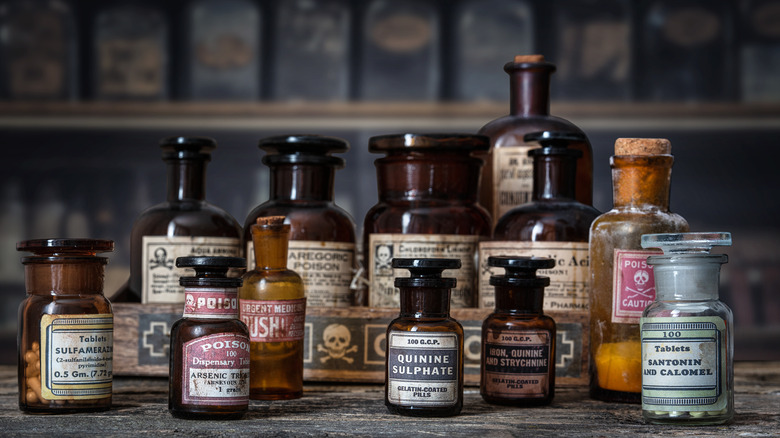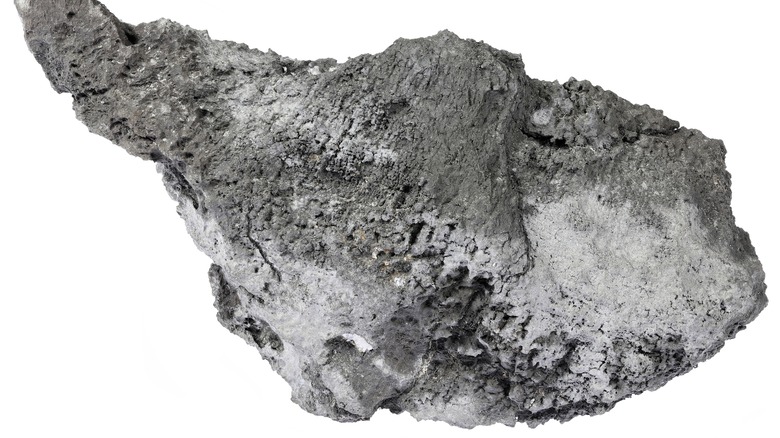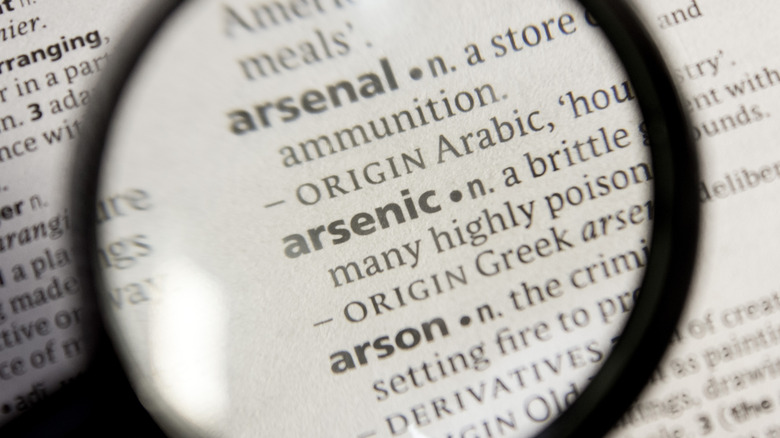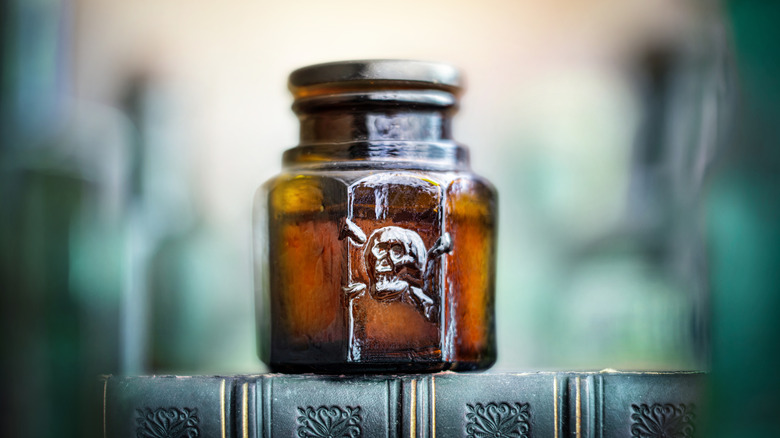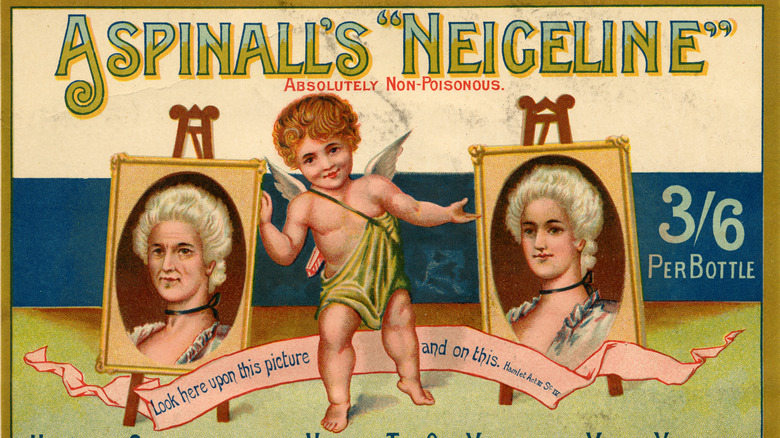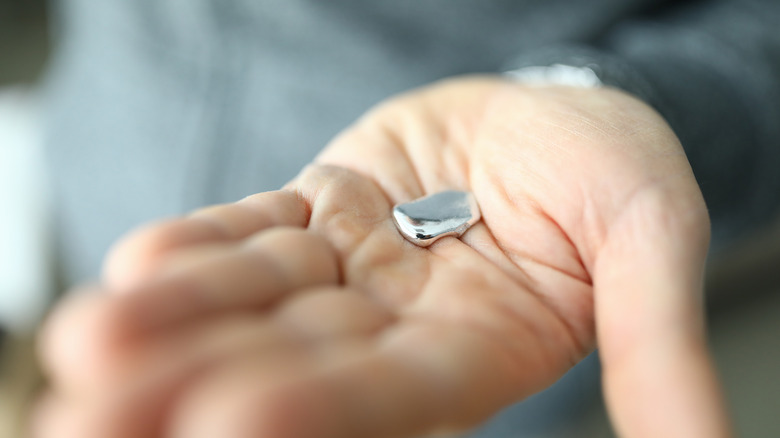Why Some People Used To Eat Arsenic As A Beauty Treatment
When you think of beauty-boosting snacks, what do you think of? Collagen-rich protein powders? Fresh, raw vegetable juices? Eating the placenta after birth? Whatever comes to your mind, it's probably not arsenic. Yet that deadly chemical compound is just what some people used to chow down on to give themselves a youthful glow (via The Guardian).
Arsenic is one of the most famous poisons of all time. Because it's a naturally occurring element, accidental arsenic poisoning via water sources is possible, according to Live Science. However, arsenic is also known to be a vector of deliberate poisonings, reports research program Dartmouth Toxic Metals. Depending on the amount ingested, arsenic can either kill someone immediately or result in a slower, creeping type of death.
In any case, it doesn't sound like a fun time. But still, some people voluntarily exposed themselves to arsenic. Why? Well, it had something to do with a sensationalized chemistry book and a group of Austrian women (via The Ultimate History Project).
What is arsenic?
Arsenic is a natural element that, like salt or diamonds, can be found in the ground, according to Live Science. However, unlike salt or diamonds, arsenic is no benign item — it is very dangerous and can be deadly if inadvertently consumed.
Still, you might be surprised how many different uses there are for arsenic. For instance, though it is less common than it used to be, some insecticides still contain arsenic, according to the Agency for Toxic Substances and Disease Registry. Arsenic is also sometimes used in manufacturing processes, the agency notes, such as in the production of glass. Historically, arsenic was used for many more purposes, but health concerns have led many manufacturers to stop using arsenic in their production lines.
Though exposure to small amounts of arsenic is not necessarily deadly, it can cause health effects, including increased risks of major diseases like cancer and diabetes (via World Health Organization). Each year, more than 140 million people are exposed to unsafe amounts of arsenic.
The Austrian arsenic eaters
Health agencies worldwide now share concerns about the dangers of consuming or being exposed to arsenic. But though experts now advise against exposure to arsenic, there was once a prominent scientific theory that exposure to this deadly compound could actually benefit the person who ingested it (via The Ultimate History Project). The evidence behind this idea? It all stemmed from the observation of a group of people living in Austria in the 1860s. Despite the apparent risks, scientists say that the group seemed to frequently consume arsenic in the same way that a modern parent might consume caffeine: to get a bit of an energizing kick.
The practice was apparently started by people who sampled a compound they found in their mines, according to Vice. They felt stronger and more energized after consuming the compound, so they continued to eat it regularly, starting on a low dose before graduating to a more substantial portion.
How people survived eating arsenic
The compound, of course, was arsenic. But how were people able to survive the regular consumption of such a deadly substance? Well, not everyone did: There were lots of people who accidentally overdosed, enough so that the government tried to regulate the distribution of the compound, but they were largely unsuccessful (via Vice).
As to those who did survive, scientists put their heads together and came up with a variety of potential reasons for their unexpected survival. One theory is that the people weren't actually consuming arsenic, according to The Ultimate History Project. Instead, they consumed something that looked like arsenic but was not deadly. Other doctors said that perhaps by consuming arsenic regularly over time, people started to build up a resistance to its negative effects, allowing them to reap the rewards of the element.
Nowadays, scientists say that you can't just ingest a lot of arsenic to make yourself immune to poisonings (per The Guardian). But some research has suggested that there may be certain genes that can give people higher resistance to arsenic. These genes can't be "triggered" by arsenic consumption, so if you don't have them already, you're out of luck. But in some Chilean communities, where there are high levels of arsenic in the water, evidence suggests a selective preference for these genes may have led to their dominance over time.
How arsenic became a beauty product
So with all that, how did women come to adopt arsenic as a beauty product? It had a lot to do with glowing reports coming from scientists about women in Austria at that time, according to The Ultimate History Project. They described local women as benefiting greatly from the regular consumption of arsenic, which kicked off a beauty trend abroad as other women hoped to see the same positive impacts. Some of the most popular ways to eat arsenic included edible wafers, which were meant to remove blemishes and promote a pale complexion, National Geographic notes.
Unfortunately, the pursuit of beauty did not end happily for everyone. As Vice notes, many of the people who died of accidental arsenic poisoning were actually women and girls who were seeking the compound's so-called beautifying effects. And considering the negative affects of arsenic consumption we know about today, more may have suffered from subtler, long-term illnesses.
Other deadly beauty and medical products
Though the historical consumption of arsenic is an undeniably interesting topic, it's worth noting that it's far from the only poisonous substance humans have ingested for the sake of bettering themselves. Among the dangerous past beauty trends include using toxic lead in face makeup, such as eyeliner and foundation (per Bustle). And deadly belladonna was once used as an eyedrop solution to make women's pupils wider and their eyes more appealing, according to Insider.
On the medical side of things, one of the most famously misguided treatments of all time was mercury. Many different medical treatments containing mercury were promoted for a variety of ills, from yellow fever to babies teething (via the Toronto Star). At one point, centuries ago, people even thought that mercury might hold the key to living forever, according to History of Yesterday.
